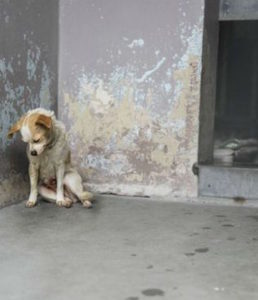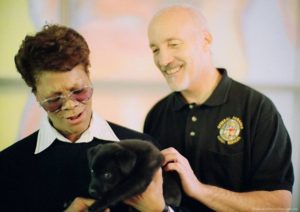A substantial number of animals euthanized in animal shelters each year are feral cats and their neonate offspring. A program to control the homeless cat population by neutering instead of culling cats in shelters is critical to achieving No-Kill.
TNR has proven to be an effective and workable program for long-term population control and is increasingly being utilized by public and private entities to address feral cat populations and the concomitant problems of protecting the public health from rabies and cat nuisance complaints. It has been demonstrated to reduce over populations, complaints about roaming and the number of cats in shelters in communities in the United States and abroad. It reduces euthanasia rates, and costs less than half of the cost of traditional trap and kill programs. Dr. Julie Levy, DVM, Ph.D., monitored an eleven-year TNR project that involved eleven feral cat colonies on a central Florida campus. Dr. Levy concluded that “a comprehensive long-term program of neutering followed by adoption or return to the resident colony can result in reduction of the free roaming cat population in urban areas.”
TNR is working successfully in New Jersey in model TNR programs in Cape May, Atlantic City (at the Boardwalk), Phillipsburg and Bloomfield. In addition, support for TNR was one of the top three recommendations of New Jerseyans in comments received at public hearings on the topic.
Elsewhere in the country, the Orange County, Florida, Animal Services Department, the San Francisco SPCA, and statewide programs in California and Utah have successfully implemented TNR programs. Maricopa County, Arizona and correctional institutions in Ohio, Montana and New York State have also officially approved TNR as a means to feline population control. These programs are additionally beneficial to local governments, as volunteers can often be found to assist municipalities in managing feral cat colonies but are generally not willing to assist in trapping and removing cats for euthanasia.
Examples of successful TNR programs include:
Alachua County, Florida: A program called Catnip was implemented in 1998 and is responsible for sterilizing more than 22,000 cats since then. The program decreased shelter intake of cats by 61% since 2000.
Maricopa County, Arizona: Ed Boks, former Director of Animal Care and Control, Maricopa County, Arizona, studied conventional methods of feral cat control for over 20 years. He determined that these methods do not properly regulate the population and, consequently, initiated a TNR program that is operated by the county animal control department. Within eight years the euthanasia rate dropped from 23 cats per 1,000 county residents to only eight cats per 1,000 county residents.
Orange County, Florida: Orange County, Florida has a population of 700,000 people. Its animal control department incurs costs of approximately $105 per animal when it must respond to a complaint and impound and euthanize the animal. Before its TNR program was introduced, there were approximately two hundred complaints per year, resulting in as many animals being captured, with a cost of $21,000 to the county. Within six years after the introduction of TNR by animal control services in 1995, complaints decreased by approximately 10% as did the number of impoundments, with a total savings to animal services of over $100,000. Within the six years of the start of the program, euthanasia decreased by 18%.
San Diego, California: Founded in 1992 by Dr. Rochelle Brinton, the Feral Cat Coalition (FCC) introduced TNR to San Diego on a countywide basis. FCC is an all volunteer organization that provides free sterilization procedures for feral and stray cats. In addition to sterilization procedures, the cats are vaccinated for rabies and treated for fleas and any immediate medical problems. FCC volunteers monitor the feral cats after they are returned to the outdoors. The local animal control departments support the program as it has had a positive impact in reducing the feral population, thus reducing the number of cases to which they would have otherwise been required to respond. By 1994, two years after the start of the TNR program, the total number of cats brought into San Diego shelters dropped over 34% and the euthanasia rates in county shelters for all cats dropped 40% (instead of the usual 10% increase). San Diego euthanized 8.0 shelter animals per 1,000 people in 1997; 4.9 in 2002. The reduction in the euthanasia rate translated to an estimated tax savings of $795,976.
San Francisco, California: The San Francisco SPCA initiated a citywide TNR program in 1993. The SPCA has been working with feral cat caregivers to control the feral cat population, provide some medical care, keep the cats adequately fed and, when possible, adopt them into homes. There are three aspects to the program. The first is “feral fix,” a program through which the SF/SPCA provides vaccinations and spay/neuter surgery for San Francisco feral cats, all at no charge to their caregivers. Since the program began they report altering over 10,000 cats. The second aspect of the program is “Cat Assistance Teams.” In neighborhoods throughout the City, CAT members work together to humanely trap feral cats, transport them to Feral Fix, provide post-surgery recovery care, and socialize feral kittens before placing them in homes. CAT members also provide expert advice and assistance to novice caregivers in their neighborhoods. Finally, there is 9 Lives™ Humane Feral Cat Management Video Series including nine comprehensive videos that cover all aspects of caring for feral cats. Within six years of commencing the TNR program, euthanasia rates dropped 70%.
New York City, NY: The New York City Feral Cat Council (“NYCFCC”) is a coalition of NYC animal groups working to humanely reduce the City’s feral cat population through the use of TNR. They established a TNR program on the Upper West Side of Manhattan in 1999. Based on statistics compiled by New York City’s Animal Care and Control, the number of stray cat intakes from the Upper West Side was reduced 73% in the first three years of the program. During the first year of the program, there was a 59% reduction in the number of cats arriving in shelters.
Cape May, New Jersey: In 1995, John Queenan, with the Cape May City Animal Control, proposed an ordinance to facilitate TNR and the feeding of feral cat colonies. Queenan based his proposal on similar regulations in Santa Cruz County, California. Because pick-up and euthanasia had not resolved the city’s overpopulation problem, the ordinance focused on preventing reproduction. As a result of Cape May’s ordinance change, 200 cats were altered in 1997. Based on the number of nuisance complaints, litters of kittens and visual sightings of the colonies, it is estimated that the feral cat population, which was between 500 and 800 cats in 1994, has been reduced by 50%.
Atlantic City, New Jersey: The Humane Society of Atlantic County, in conjunction with the Health Department of Atlantic City and local volunteers, has used TNR successfully and with municipal approval. Through kitten adoptions and natural attrition (since these cats no longer reproduce), the feral cat population under the Atlantic City boardwalk was reduced by more than 70% within three years. Cat related nuisance complaints, common before enactment of the TNR ordinance, are now rare.
Phillipsburg, New Jersey: Phillipsburg, Warren County also authorized TNR. Dr. Robert Blease, a veterinarian and founder of Common Sense for Animals (“CSA”), a non-profit organization that receives no public funding, initiated the municipality’s TNR ordinance in 2001. All feral cats that are brought to CSA are vaccinated, sterilized, and identified by way if ear notching. Cats that are infected with FIV/FEHV, unhealthy or vicious, are humanely euthanized. Since Phillipsburg authorized TNR the stray cat population has reportedly dropped an estimated 350 cats in the first year alone, and citizen complaints about stray cats have dropped to zero.
Bloomfield, New Jersey: The Friends of the Bloomfield/Bukowski Animal Shelter (FOBAS) initiated a TNR program September 2003 with two colonies. The program has been endorsed and supported by the mayor, the town council and the Bloomfield Department of Health. Neighborhood Cats, a New York City-based volunteer non-profit organization, provides advice and assistance to the town, which adopted TNR as its official feral cat program.
For information on the sources for the above information as well as how to calculate the feral cat population in your community refer to Analysis of Feral Cat Solutions.



 More than a policy and statistical objective, “no-kill” is a principle, an ethic, and once applied the practical consequences begin to fall into place. The principle is that animal shelters should apply the same criteria for deciding an animal’s fate that a loving pet guardian or conscientious veterinarian would apply. That is, healthy and treatable animals are not killed simply because of a lack of room or resources to care for them.
More than a policy and statistical objective, “no-kill” is a principle, an ethic, and once applied the practical consequences begin to fall into place. The principle is that animal shelters should apply the same criteria for deciding an animal’s fate that a loving pet guardian or conscientious veterinarian would apply. That is, healthy and treatable animals are not killed simply because of a lack of room or resources to care for them.

